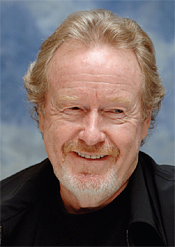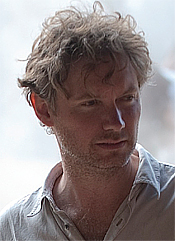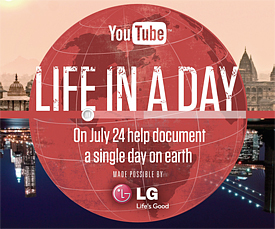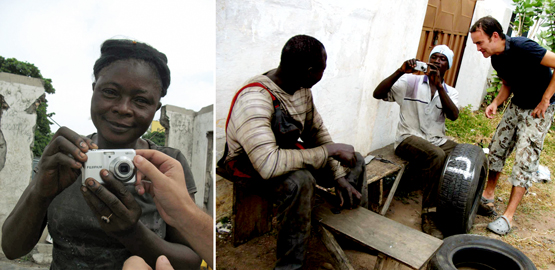Democratizing Media
LOS ANGELES

Ridley Scott YouTube's latest social networking experiment involves crafting a feature film from thousands of user submissions.
Filmmakers Ridley Scott (executive producer) and Kevin MacDonald (director) are piloting the project, which involves soliciting video clips of lives lived on July 24 and culling a documentary from them called "Life in a Day," which is slated to debut next January at the Sundance Film Festival.

Kevin MacDonald "I'll be honest, the idea scared us at first," said John Cooper, director of the Sundance Film Festival. Noting who was at the helm, he put his qualms aside and booked the showing. Still, he conceded, "I have no idea what to expect."
Dermott Boden, chief marketing officer for LG Electronics, which is co-sponsoring the project, sees the film as a way to connect his brand with "people all over the world" even though no LG Electronics equipment was used in making it.
The two entities have shared the world stage since at least January 2009, when LGE unveiled HDTV sets that linked to YouTube. This July, LGE announced that its new LED HDTVs, equipped with a 3D-capable network and a Blu-ray Disc player, would also offer connectivity to YouTube content.
THE PITCH
Videographers had to be at least 13 years of age to shoot and submit a video; release forms were supplied for minors and persons included in the footage. They could not be residents of Cuba, Iran, North Korea, Sudan, Myanmar (Burma), Syria, or any other U.S.-sanctioned country.
Although guidelines stated that any footage—including mobile phone video—was acceptable, higher resolution and higher quality sound were encouraged. Submitters were urged to hold on to their original, highest resolution footage just in case their material was selected (upload compression lessens quality).

Official "don'ts" included footage of anything attributable to a licensed source: trademarks and brands; a poster of a famous person or artwork; movie, TV, music, video clips, photographs.
There were no limits on style or languages used, but an identifier was requested for non-English submissions at the beginning of the clip. Although the official guidelines stated that there was no limit on the length of footage, film editor Joe Walker noted that "YouTube will stop it off to 10 minutes." For those compelled to go beyond 10 minutes, he recommended labeling segments of their opus 'one of however many segments there were,' 'two of ...,' and so on.
Walker also requested the submission of raw (unedited) footage, free of captions and time/date stamps.
Otherwise, videographers were urged to be imaginative, personal and visual. All entries had to be uploaded between July 24 and July 31. This was accomplished by clicking on a SUBMIT tab that appeared on the "Life in a Day" channel on July 24, along with instructions.
"There is no excuse—you have a digital camera, go out and shoot your film," said Ridley Scott in a mid-July video clip for the website. "Nothing should put you off and nothing should put you down. Just do it."
As for audio, sound designer Matthew Herbert suggested recording the following for the soundtrack he'll be working on: a single hand clap; a single note sung for as long as possible; one breath in and out; and a favorite sound. Herbert introduced himself to participants by noting "the main thing I do is make music out of sounds." He demonstrated this by playing the first track of the "Plat du Jour" album he did for his Accidental Records label: it's a compendium of ambient feedback from 40,000 chickens.
MAKING IT HAPPEN
With Scott and MacDonald at the helm, "they didn't have a problem activating the YouTube audience," said Rick Smolan, founder of Sausalito, Calif.-based Against All Odds Productions, which specializes in the design and execution of large-scale global media projects. "But they realized that if the whole film was simply people on YouTube talking to each other it would represent a really small fraction of the human race."
His company was contracted for international outreach by Google, which had sponsored a number of its projects over the past seven years. In less than a month, AAOP's network of contacts distributed 650 Fujifilm FinePix AV100 cameras to remote areas in about 40 countries, said Smolan.
The 12-megapixel cameras can capture 720p HD video, enable panoramic shots and are SD/SDHC memory card compatible.
"We wanted cameras that could run on AA batteries," said Smolan. "We realized that in some places there might not be electricity."
His onsite contacts translated the video instructions and sent representatives out into the field to deliver the cameras, train the videographers and handle the paperwork. Google prepaid for DHL shipment of the camera's memory cards to Ridley Scott's Scott Free production company in London, bypassing the YouTube upload. The videographers got to keep the cameras.

Fuji digital AV100 cameras were distributed in Ghana by Architecture for Humanity. By July 30, the project had already collected "30,000-40,000 entries," according to director Kevin MacDonald.
YouTube has publicized the endeavor as its latest "promise to bring the collaboration and democratization of YouTube to another level." It follows on the heels of the "YouTube Symphony Orchestra" and "YouTube Play."
In December 2008, YouTube launched the first online collaborative orchestra, calling for open entries through January 2009. Finalists were voted on by the YouTube community in February and the winners performed at New York's Carnegie Hall in April under the direction of Michael Tilson Thomas.
In June, "YouTube Play," co-sponsored with HP, was introduced to showcase up to 20 videos at New York's Solomon R. Guggenheim Museum on Oct. 21, 2010. Simultaneous presentations are slated for Guggenheim museums in Berlin, Bilbao and Venice, and will be available to a worldwide audience on the YouTube Play channel.
Get the TV Tech Newsletter
The professional video industry's #1 source for news, trends and product and tech information. Sign up below.
